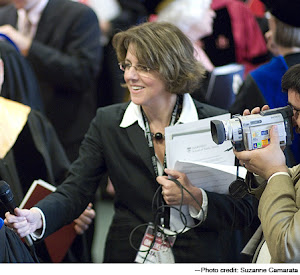A barrier-breaking generation gives context to contemporary female life.
Saturday, September 12, 2009
Tigers and Tigresses: 40th Anniversary of Coeducation at Princeton
Women in the Nation's Service: On the 40th Anniversary of the Coeducation of Princeton University
Forty years ago this September, on the first weekend after Labor Day, a group of just over 170 young women set foot on the Princeton campus as bona fide members of the University’s 3,400-strong student body. Their steps onto the ivied campus and into the old stone classrooms constituted an historic milestone for the more than 200-year-old Princeton, but it was also recognized as a symbolic act for a nation that was grappling with issues of equity in civil rights and women’s rights. For until that fall of 1969, young women, no matter their intelligence and potential, were still excluded from some of the greatest centers of learning in the United States -- Princeton, Yale and Dartmouth -- while several others of the Ivy League colleges maintained a technical distance from women by admitting them only through "sister schools".
Although Yale University also went coed that same fall, it was Princeton that attracted television cameras, high jinx and hoopla as we arrived at the designated women’s dormitory, Pyne Hall, on a sunny afternoon, the yellow bees buzzing around the juice and cookies that had been placed on tables in the courtyard. Princeton and its Gothic architecture, beauty and fraternal traditions had been advertised for decades to thousands of high school English classes through its best publicist, Princeton alumnus F. Scott Fitzgerald, in his semi-autobiographical novel "This Side of Paradise."
Princeton’s decision had come haltingly and hastily in the spring of 1969 as a means to blur its “old boy” image and stay competitive, recognizing that top high school students were showing Woodstock-era preferences for coed colleges. By admitting just a sprinkling of young women, Princeton became a coed institution that year in name only, our presence serving as a test case. Would we make it?
And so that September we were greeted by a welcoming committee of male student guides who gallantly carried our luggage up the steep flagstone steps to our dorm rooms. But we also soon heard about the outraged alumni who saw in us teenaged girls the slipping away of the all-male Princeton paradise that they'd known. In letters to the University and to the alumni magazine, furious male alumni baldly suggested that Princeton was wasting student slots on women -- who would only get married and tend house afterwards -- even mounting a discredited movement some 10 years later to "Bring Back the Old Princeton."
But the education of women at Princeton moved on with hundreds more women admitted each year until eventually they constituted half the student body. And their education was not wasted. For the fruits of Princeton's coeducation decision are being seen now, as the generations of Princeton alumnae mature into important roles in society and fulfill the University's time-honored creed of "Princeton in the Nation's Service." This year in particular, in the Obama Administration, Princeton women are highly visible: Anne Marie Slaughter '81, Director of National Security Policy, Elena Kagan '81, Solicitor General of the U.S. and former Dean of Harvard Law School, Supreme Court Justice Sonia Sotomayor '76 and, of course, First Lady Michelle Obama '85. Princeton had also produced Pulitzer Prize winner Annalyn Swan '73 and entrepreneurs Meg Whitman '79, ex-CEO of eBay and Wendy Kopp '89, the visionary founder of Teach for America. There are female doctors, engineers, bankers and Olympic athletes, all with Princeton degrees and orange and black reunions jackets in their closets.
These women, carrying on in the nation's service, rebuke any lingering notion in this country that the best education afforded a young man might be wasted on a young woman. But elsewhere in the world there remains an unfinished agenda to afford equal education to girls and women -- places where women are worth only the price of the dowry they will bring to a household or the babies they will make; where those girls with the temerity to walk to a school may have acid thrown in their faces or be beaten. Places where the potential of half a country's citizenry is thrown away.
Economists, demographers and health researchers have lately demonstrated that the most effective way to improve the economic strength of a country and improve the health of its citizens is to educate girls and women. The United Nations Millennium Development Goals include the equal education of girls as one of its chief aims. Yet, in many countries, girls and women are still denied an education on the basis of their gender and are thus condemned to illiteracy, poverty and dependence.
There are now 24,000 female alumni of Princeton University. As we remember this week that decision of 40 years ago and our steps onto the leafy campus of one of America's finest and most prestigious academic institutions, we should also recall the work that remains to allow girls and women around the globe to contribute their full potential in their own nations' service by enjoying equal access to the education that is their human right.
Labels:
coeducation,
Elena Kagan,
Michelle Obama,
Princeton,
Sotomayor
Subscribe to:
Posts (Atom)



